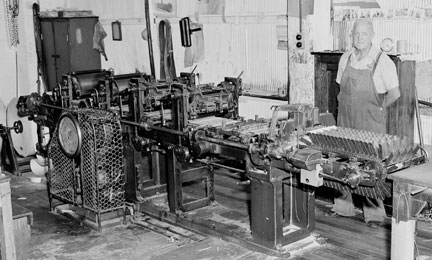Place your bets
On Melbourne Cup Day, if on no other day of the year, most Australians take a punt via the ubiquitous Cup 'sweep'. Australia is one of the few countries in the world that allows bookmakers to operate on-course and the automatic totalisator, or 'tote', is another Australian betting innovation.
Detail from The betting ring at Flemington, c.1889, by Carl Kahler
The Australian bookmakers' mode of operation has evolved since they first appeared on race tracks in the mid 19th century. Working around the laws controlling betting, at first bookmakers did not take cash bets but operated on credit. Later, to avoid the prohibition of taking a bet in a 'place', they roamed the course. In 1882, the VRC (Flemington) introduced a bookmakers' registration scheme which required bookmakers to pay a £25 licence and the ARC (Randwick) soon followed suit. After the legalisation of on-course betting in 1906, bookmakers began to stand on the same 'pitch', with a clerk wearing a bag containing money and issuing betting tickets.
Taking a punt: SP bookies and the Tote
The legalisation of betting on racecourses in New South Wales was an attempt to confine betting to racetracks aimed at stamping out 'SP' betting shops.
The SP (Starting Price) bookmaker paid out according to the prices being quoted on the racecourse when the race started - before the telephone, on-course prices were illicitly signalled out of the course with flags.
Even though the making or taking of a bet anywhere outside the race track was illegal - with the punter and the bookie deemed equally criminal - this didn't stop Australians from regularly breaking the law. In every second household, on every Saturday afternoon, the average punter went to the local pub, corner grocer, barber or milkman when they wanted to place a bet with their SP bookie.
In the spring of 1916, the AJC introduced Sydneysiders to the grand Totalisator Machine at Randwick Racecourse. Invented in 1913 by George Julius, an engineer working in Western Australia, the totalisator machine was developed in the 1890s as a 'cheat proof' mechanical vote-counting machine. When no buyers could be found in Australia, Julius looked for new uses for his 'calculator'. He decided that his machine would make a perfect automatic totalisator for the counting of betting tickets, the calculation of changing odds and the paying of dividends to winning punters.
Totalisator machine, 14 Feb 1955, Government Printing Office Collection
Photograph GPO 2 06212
As the world's first automatic totalisator, this machine replaced a labour intensive non-mechanical system and for decades Julius' company dominated the design and supply of racecourse betting equipment throughout the world. The 'tote' operated in competition with the on-course bookies who fought its introduction, believing that it would make betting easier for the punter.
The Cup sweep
Melbourne Cup sweepstakes have been staged since the Cup was first run in 1861. The term 'sweepstake' originated in horse-racing, where each entrant in the sweepstake would put up a stake, and the winner would sweep all stakes.
At most schools, workplaces, pubs and clubs - not to mention the hundreds of Cup parties and luncheons staged across Australia - the running of social sweeps is the most significant ritual of Cup day.
Melbourne Cup 'sweeps' involve the sale of tickets denoting the names of horses in the race, with the holder of the winning horse ticket and the two place getters taking their prize money from the pooled funds. Sweep forms, as we now know them, began appearing in newspapers in about 1960, when direct television broadcasting enabled the live telecasting of the Cup to most parts of the country.
In the 1940s and 1950s, Australian Women's Weekly staff cartoonist William Edwin Pidgeon (1909-1981), or 'Wep', produced an iconic series of annual Melbourne Cup covers which really captured the spirit of this national sporting event as cherished by all Australians.
Many of Wep's 'Weekly' covers are now regarded as classic illustrations of everyday Australian life. His 1946 Cup cover is titled 'Winners Circle' and depicts the losing jockey's face green with envy. The 1950 Cup cover shows office workers crowded around a radio to hear the race call, while in 1953, Wep turned his eye on the average Australian family making their 'sweep' draw in the lounge room of their home. 1956 saw a focus on fashion and 1959 highlighted the innovation of television broadcasting.




